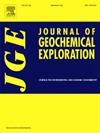坦桑尼亚西北部 Karagwe Ankolean 矿带岩浆岩的微量元素地球化学和锆石 U-Pb 地质年代:对成岩学和镍铜钴勘探的影响
IF 3.4
2区 地球科学
Q1 GEOCHEMISTRY & GEOPHYSICS
引用次数: 0
摘要
在坦桑尼亚西北部,中生代卡拉格韦-安科伦带(KAB)的阿卡尼亚鲁和卡盖拉超群岩侵入了岩浆岩。报告了痕量元素地球化学和 UPb 地质年代学的结果,以揭示这些山体的岩石成因和地质年代演变,从而对 KAB 的镍铜钴矿床的远景提出限制。闪长岩为亚碱性辉长岩和辉绿岩。它们是相对演化的 Mg# = 43-69,过渡金属含量低于卡班加-穆松加提排列(KMA)侵入体的幼年黑云母-超黑云母岩。这些岩浆可细分为西部和东部岩群,它们显示出类似的地球化学特征,包括相对于 HFSE(高场强元素)富集的 LREE(轻稀土元素)、LILE(大离子亲岩元素)、Pb、Th 和 U。它们的特征是:在原始地幔归一化蛛状图中,Nb-Ta-Ti 元素减少;在软玉岩归一化 REE 蛛状图中,LREE 元素富集,MREE 和 HREE 元素相对平缓,Eu/Eu* = 0.74-0.94 为负 Eu 异常。这些元素与痕量元素比Nb/Yb、Th/Yb、Zr/Nb、Ba/Nb和Nb-Yb-Ti指数一起表明,岩浆岩来自次大陆岩石圈地幔源,随后经过碎裂结晶和地壳污染。锆石UPb地质年代测定结果显示,西部山体中的榴辉岩的加权年龄为1424 ± 13 Ma,东部山体中的辉长岩的上年龄截距为1411 ± 54 Ma。这些成岩年龄与 KMA 和维多利亚湖辉绿岩堤群(LVDDS)的成岩年龄相似。与 KMA 和 LVDDS 在时间和地球化学方面的相似性支持了岩浆岩在地壳内部裂谷环境中的形成。虽然KAB岩体的地球化学演化程度相对较高,但它们与KMA侵入体中的镍铜钴矿化幼体有着相似的演化路径,即与含硫乡土岩的严格互动。我们建议将痕量元素地球化学,包括磨屑的亲铝元素比率(镍/铬和铜/锌),作为矢量来定位 KAB 的潜在镍铜钴目标。本文章由计算机程序翻译,如有差异,请以英文原文为准。
Trace element geochemistry and zircon U-Pb geochronology of mafic sills from the Karagwe Ankolean Belt of northwestern Tanzania: Implications for petrogenesis and Ni-Cu-Co prospectivity
In northwestern Tanzania, mafic sills intruded the Akanyaru and Kagera Supergroup rocks in the Mesoproterozoic Karagwe-Ankolean Belt (KAB). Trace element geochemistry and U![]() Pb geochronology results are reported to unravel petrogenetic and geochronological evolution of the sills in order to place constraints on Ni-Cu-Co prospectivity of the KAB. The sills are subalkaline gabbronorite and dolerite. They are relatively evolved Mg# = 43–69, with transitional metal contents lower than juvenile mafic-ultramafic rocks of the Kabanga-Musongati Alignment (KMA) intrusions. The sills can be subdivided into western and eastern swarms that display similar geochemical characteristics, including enrichment in LREE (Light Rare Earth Elements), LILE (Large Ion Lithophile Elements), Pb, Th, and U relative to HFSE (High Field Strength Elements). They are characterised by depletions of Nb-Ta-Ti in primitive mantle normalised spiderplots, enrichments in LREE and relatively flat MREE and HREE with negative Eu anomalies Eu/Eu* = 0.74–0.94 in chondrite normalised REE spiderplots. Together with elemental trace element ratios Nb/Yb, Th/Yb, Zr/Nb, Ba/Nb, and Nb-Yb-Ti index suggest derivation of the mafic sills from a sub-continental lithospheric mantle source followed by fractional crystallisation and crustal contamination.
Pb geochronology results are reported to unravel petrogenetic and geochronological evolution of the sills in order to place constraints on Ni-Cu-Co prospectivity of the KAB. The sills are subalkaline gabbronorite and dolerite. They are relatively evolved Mg# = 43–69, with transitional metal contents lower than juvenile mafic-ultramafic rocks of the Kabanga-Musongati Alignment (KMA) intrusions. The sills can be subdivided into western and eastern swarms that display similar geochemical characteristics, including enrichment in LREE (Light Rare Earth Elements), LILE (Large Ion Lithophile Elements), Pb, Th, and U relative to HFSE (High Field Strength Elements). They are characterised by depletions of Nb-Ta-Ti in primitive mantle normalised spiderplots, enrichments in LREE and relatively flat MREE and HREE with negative Eu anomalies Eu/Eu* = 0.74–0.94 in chondrite normalised REE spiderplots. Together with elemental trace element ratios Nb/Yb, Th/Yb, Zr/Nb, Ba/Nb, and Nb-Yb-Ti index suggest derivation of the mafic sills from a sub-continental lithospheric mantle source followed by fractional crystallisation and crustal contamination.
Zircon U![]() Pb geochronology yields a concordant weighted age of 1424 ± 13 Ma for a gabbronorite in the western sills and an upper age intercept of 1411 ± 54 Ma for a dolerite in the eastern sills. The emplacement ages are similar to those of the KMA and the Lake Victoria Dolerite Dyke Swarm (LVDDS). Temporal and geochemical similarities with the KMA and LVDDS supports for emplacement of the mafic sills in an intracratonic rift setting. Although the KAB sills are relatively more geochemically evolved, they share similar evolutionary path with Ni-Cu-Co mineralised juvenile KMA intrusions, sensu stricto interaction with sulphur bearing country rocks. We suggest that trace elements geochemistry including chalcophile elemental ratios (Ni/Cr and Cu/Zn) of the sills be applied as vectors to locate prospective Ni-Cu-Co targets in the KAB.
Pb geochronology yields a concordant weighted age of 1424 ± 13 Ma for a gabbronorite in the western sills and an upper age intercept of 1411 ± 54 Ma for a dolerite in the eastern sills. The emplacement ages are similar to those of the KMA and the Lake Victoria Dolerite Dyke Swarm (LVDDS). Temporal and geochemical similarities with the KMA and LVDDS supports for emplacement of the mafic sills in an intracratonic rift setting. Although the KAB sills are relatively more geochemically evolved, they share similar evolutionary path with Ni-Cu-Co mineralised juvenile KMA intrusions, sensu stricto interaction with sulphur bearing country rocks. We suggest that trace elements geochemistry including chalcophile elemental ratios (Ni/Cr and Cu/Zn) of the sills be applied as vectors to locate prospective Ni-Cu-Co targets in the KAB.
求助全文
通过发布文献求助,成功后即可免费获取论文全文。
去求助
来源期刊

Journal of Geochemical Exploration
地学-地球化学与地球物理
CiteScore
7.40
自引率
7.70%
发文量
148
审稿时长
8.1 months
期刊介绍:
Journal of Geochemical Exploration is mostly dedicated to publication of original studies in exploration and environmental geochemistry and related topics.
Contributions considered of prevalent interest for the journal include researches based on the application of innovative methods to:
define the genesis and the evolution of mineral deposits including transfer of elements in large-scale mineralized areas.
analyze complex systems at the boundaries between bio-geochemistry, metal transport and mineral accumulation.
evaluate effects of historical mining activities on the surface environment.
trace pollutant sources and define their fate and transport models in the near-surface and surface environments involving solid, fluid and aerial matrices.
assess and quantify natural and technogenic radioactivity in the environment.
determine geochemical anomalies and set baseline reference values using compositional data analysis, multivariate statistics and geo-spatial analysis.
assess the impacts of anthropogenic contamination on ecosystems and human health at local and regional scale to prioritize and classify risks through deterministic and stochastic approaches.
Papers dedicated to the presentation of newly developed methods in analytical geochemistry to be applied in the field or in laboratory are also within the topics of interest for the journal.
 求助内容:
求助内容: 应助结果提醒方式:
应助结果提醒方式:


